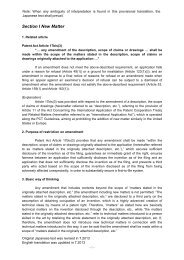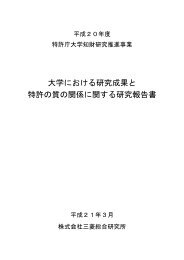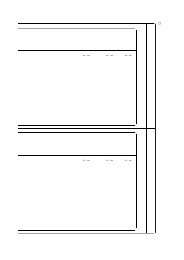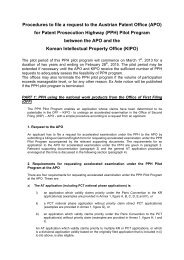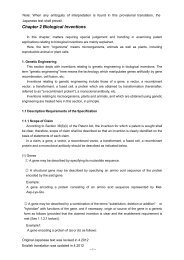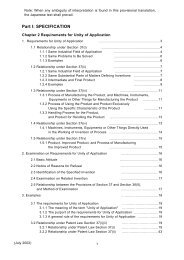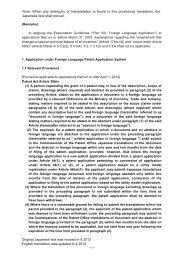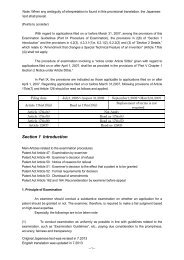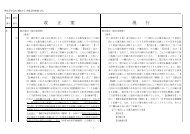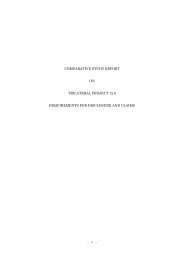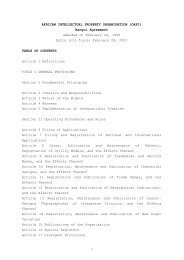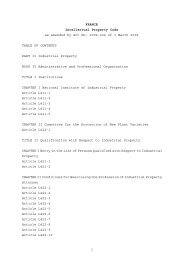Chapter 2 Novelty and Inventive Step - Japan Patent Office
Chapter 2 Novelty and Inventive Step - Japan Patent Office
Chapter 2 Novelty and Inventive Step - Japan Patent Office
Create successful ePaper yourself
Turn your PDF publications into a flip-book with our unique Google optimized e-Paper software.
Part II <strong>Chapter</strong> 2 <strong>Novelty</strong> <strong>and</strong> <strong>Inventive</strong> <strong>Step</strong><br />
(2) However, when the invention is clearly described in the claims <strong>and</strong> meanings of the<br />
words in the claims, or matters used to specify the inventions, are defined or explained in the<br />
specification <strong>and</strong> drawings, the specifications <strong>and</strong> drawings are taken into consideration to<br />
interpret the words. In addition, examples of more specific concepts developed under the<br />
concepts of the words in the claims, which are merely provided in the detailed description of the<br />
inventions or drawings, are not included in the words defined or explained.<br />
Also, when the description in the claims is not clear enough to be understood <strong>and</strong> the<br />
description could be specified by interpreting the words in the claims based on the specifications,<br />
drawings <strong>and</strong> technical knowledge as of the filing, they are taken into consideration to identify the<br />
invention.<br />
[Example 1] Terms in specifications should be technical terms in the normal sense <strong>and</strong><br />
underst<strong>and</strong>ing or interrupting some terms in specifications may require looking them up in<br />
dictionaries to find their definitions. However, it is not appropriate to only look them up in<br />
dictionaries to underst<strong>and</strong> or interrupt these terms. The descriptions in the specifications or<br />
drawings should primarily be analyzed to underst<strong>and</strong> or interpret meanings or details of the terms<br />
in the descriptions.<br />
(Reference: Decision by the Tokyo High Court, October 19, 1995<br />
[Heisei 6 (Gyo Ke) 78])<br />
[Example 2] When a technical term is not used in the normal sense in the "scope of claims"<br />
<strong>and</strong> described in the "detailed description of the invention" as such or when a technical term is<br />
too ambiguous to underst<strong>and</strong> in the "scope of claims" but it is specified in the "detailed description<br />
of the invention," there is no doubt that these terms should be interpreted based on the<br />
description of the "detailed description of the invention."<br />
(Reference: Decision by the Tokyo High Court, April 15, 1970 [Showa 41 (Gyo Ke) 62])<br />
[Example 3] For a reasonable interpretation of claims of a utility model, it should be allowed<br />
to take the detailed explanation of the device into consideration to underst<strong>and</strong> the correct<br />
meanings of technical terms or matters which are unclear in the claims of a utility model.<br />
(Reference: Decision by the Tokyo High Court, April 6, 1977 [Showa 47 (Gyo Ke) 33])<br />
(3) Claimed inventions are not identified when the inventions are not specific, even when<br />
taking the description in the specifications or drawings <strong>and</strong> the technical common knowledge as<br />
of the filing into consideration.<br />
(4) Even when an invention identified by the claims does not correspond to the invention<br />
described in the specification or drawings, the claimed invention is not identified by the<br />
specification or drawings alone without analyzing the claims.<br />
When technical matters or terms are described in the specifications or drawings but not described<br />
in the claims, the claimed invention is identified without analyzing the technical matters or terms.<br />
On the other h<strong>and</strong>, when they are described in the claims, they are always analyzed <strong>and</strong> the<br />
invention should not be identified without analyzing them.<br />
[Example 1] When the description in the "scope of claims" is specific enough to accurately<br />
underst<strong>and</strong> the details of the invention, it is not allowed to identify the claimed invention by<br />
additionally including the technical matters in the "detailed description of the invention," which are<br />
not described in the "scope of claims" at all, to underst<strong>and</strong> the details of the invention.<br />
5



